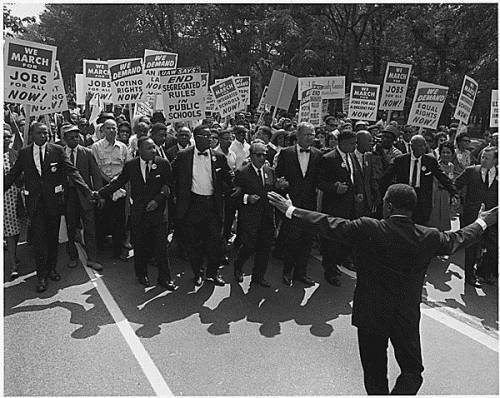
English, 12.05.2021 23:10, ununoctrium5401
80 POINTS
March on Washington Intro
The event focused on employment discrimination, civil rights abuses against African Americans, Latinos, and other disenfranchised groups, and support for the Civil Rights Act that the Kennedy Administration was attempting to pass through Congress. This momentous display of civic activism took place on the National Mall, "America's Front Yard" and was the culmination of an idea born more than 20 years before.
While the March was a collaborative effort, sponsored by leaders of various student, civil rights, and labor organizations, the original idea came from A. Philip Randolph, a labor organizer and founder of the Brotherhood of Sleeping Car Porters and the Negro American Labor Council (NALC). His vision for a march on the Nation's Capital dated to the 1940s when he twice proposed large-scale marches to protest segregation and discrimination in the U. S. military and the U. S. defense industry and to pressure the White House to take action. The pressure worked. President Roosevelt signed Executive Order 8802 (Prohibition of Discrimination in the Defense Industry, 1941) and President Truman signed Executive Order 9981 (Desegregation of the Armed Forces, 1948), and Randolph cancelled the marches.
Organizing the March
By the 1960s, a public expression of dissatisfaction with the status quo was considered necessary and a march was planned for 1963, with Randolph as the titular head. Joining Randolph in sponsoring the March were the leaders of the five major civil rights groups: Roy Wilkins of the National Association for the Advancement of Colored People (NAACP), Whitney Young of the National Urban League (NUL), Martin Luther King, Jr. of the Southern Christian Leadership Conference (SCLC), James Farmer of Congress On Racial Equality, and John Lewis of the Student Nonviolent Coordinating Committee (SNCC). These "Big Six," as they were called, expanded to include Walter Reuther of the United Auto Workers (UAW), Joachim Prinz of the American Jewish Congress (AJC), Eugene Carson Blake of the Commission on Religion and Race of the National Council of Churches, and Matthew Ahmann of the National Catholic Conference for Interracial Justice. In addition, Dorothy Height of the National Council of Negro Women participated in the planning, but she operated in the background of this male dominated, leadership group.
The March was organized in less than 3 months. Randolph handed the day-to-day planning to his partner in the March on Washington Movement, Bayard Rustin, a pioneer of the 1947 Journey of Reconciliation and a brilliant strategist of nonviolent direct action protests. Rustin planned everything, from training "marshals" for crowd control using nonviolent techniques to the sound system and setup of porta-potties. There was also an Organizing Manual that laid out a statement of purpose, specific talking points, and logistics. Rustin saw that to maintain order over such a large crowd, there needed to be a highly organized support structure.
Rustin coordinated a staff of over 200 civil rights activists and organizers to assist in publicizing the march and recruiting marchers, organizing churches to raise money, coordinating buses and trains, and administering all of the other logistical details. In many ways, the March defied expectations. The number of people that attended exceeded the initial estimates made by the organizers. Rustin had indicated that they expected over 100,000 people to attend - the final estimate was 250,000, 190,000 blacks and 60,000 whites.
A Powerful, Peaceful Protest
With that many people converging on the city, there were concerns about violence. The Washington, D. C. police force mobilized 5,900 officers for the march and the government mustered 6,000 soldiers and National Guardsmen as additional protection. President Kennedy thought that if there were any problems, the negative perceptions could undo the civil rights bill making its way through Congress. In the end, the crowds were calm and there were no incidents reported by police.
Which detail is included in the passage, but not the image?
A. the importance of equal rights to all of the participants
B. specific numbers about police presence at the March
C. the different religions represented at the March
D. the fact that protesters included men and women
How does the image enhance readers’ understanding of the participants in the March?
A. Readers can better appreciate the vast numbers of those who participated in the March.
B. It shows blacks and whites have linked arms as a sign unity at the head of the parade.
C. It clearly shows tension between religious and government leaders seeking attention in the parade.
D. Readers can see that a diverse mix of participants of different races and ethnicities attended the March.


Answers: 1
Other questions on the subject: English

English, 21.06.2019 13:30, vallhernandez13
1. explain the technique of loaded language and loaded images and provide an example of where this technique might be used in the media that you consume on a daily basis. 2. when you evaluate media, you can use a number of techniques to you evaluate critically and effectively. discuss one important technique and provide an example of how you may use it with the media you consume.
Answers: 2

English, 21.06.2019 15:00, bxbysoso
The english language has the largest vocabulary of any language in existence. it has close to a million words! the english language is also the most widely used language in the world. close to a billion speakers, at least half of which speak english as a second or foreign language. this unit takes you on a brief tour of the history of english, showing you how the language moved from its obscure beginnings to its celebrated status as the first truly global language. what is the main idea in the text?
Answers: 3

English, 21.06.2019 15:30, perezsamantha3oqr0za
In the excerpt above why does meursault say that czechoslovakian man got what he deserved ?
Answers: 1
Do you know the correct answer?
80 POINTS
March on Washington Intro
The event focused on employment discrimination, civi...
The event focused on employment discrimination, civi...
Questions in other subjects:


Mathematics, 10.11.2019 04:31



Mathematics, 10.11.2019 05:31










